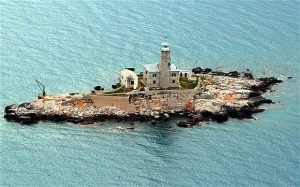
Sveti Ivan Island where alleged bones of St. John the Baptist have been found. Sveti Ivan means "St. John" (AP Photo)
Just the Facts
News has emerged recently that the bones of St. John the Baptist might have been found. The bones include a knuckle, a tooth, part of a cranium, a rib, and an ulna. Although there is no way to confirm that these are the actual bones of the New Testament prophet, information uncovered makes a strong case in favor of their authenticity. Here is a compilation of some of the facts:
(1) These bones have been radiocarbon dated to the early first century which is consistent with the New Testament account of St. John the Baptist.
(2)The dating also confirms that the bones are of one male from the Middle East.
(3) The bones were found by Bulgarian archeologists while excavating an old 4th to 5th century Church site on the island of “Sveti Ivan” which translates “St. John”.
(4) The bones were found in a marble sarcophagus underneath the altar of the Church at Sveti Ivan. About 20 inches away a smaller box was found which was inscribed: “Dear Lord, please help your servant Thomas” along with the name of St. John and the date of June 24 written on it. In the tradition of the Church June 24 is the feast day of the Nativity of St. John the Baptist. It is theorized that the smaller box might have been originally used by someone named Thomas to transport the relic to this site.
(5) It was customary for important relics to be given to monks when an important Church was being built.
(6) Many relics made their way out of Jerusalem and were brought through the ancient city of Constantinople by the 4th Century.
What Can be Proved?
Proving or even disproving that the DNA is indeed of St. John who baptized Jesus Christ is virtually impossible. However there are other reported “bones” found elsewhere in the past allegedly from the same Saint. An interesting study would be to compare the DNA of those other samples. Another thought is that if indeed these were authentic bones, they would also have the DNA of Jesus Christ, as John and Jesus were documented to be cousins in the New Testament. Biblical accounts state that St. John the Baptist was beheaded by Herod. Unfortunately, there is no information as to what became of the complete skeleton after his death, with or without head. We will never know for sure the true origin of these particular relics– at least on this side of the grave.
It is interesting that reports have emerged now as the bones were actually discovered in 2010. It is very timely for the Feast Day of the Nativity of St. John the Baptist which is on June 24. St. John the Baptist has been referred to as a New Testament prophet, the forerunner of Jesus. Even Jesus stated that “among those born of women there is no greater than John the Baptist” (Mt. 11:11).
Recognizing God
We might not be able to recognize the bones of St. John the Baptist, however we know from Sacred Scripture that he was able to recognize Jesus on more than one occasion. The first was when he jumped in the womb upon Mary’s visitation of Elizabeth, St. John’s mother. In this recognition, no human eyesight or understanding was used. He supernaturally knew that the Mother of Our Lord had approached his own mother. The second significant acknowledgement was when St. John saw Jesus approaching him for baptism. It was then that St. John pointed Jesus out to everyone by proclaiming, “Behold the Lamb of God” (Jn 1:36).
How Do You See Jesus?
What about us? Are we able to recognize Jesus in our lives? What does the face of Jesus look like? We too have to see with our supernatural and spiritual eyes. No doubt it is a grace. Some say that we can see Jesus in the poor and needy. Some say that Jesus can be seen in the Eucharist in the form of a little piece of unleavened bread and wine. Some say that they see Jesus in the hearts of others. Some see Him in dreams and others in prayer. How do you see Jesus?
Whether or not we see and understand with our eyes, minds, or hearts, there is still a lot of substance here for our faith.
(Information on the bone discovery was obtained from websites The Christian Science Monitor; National Geographic; ABC News)
